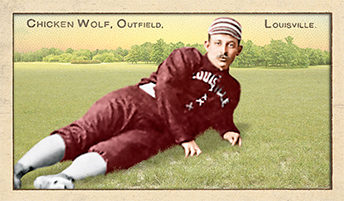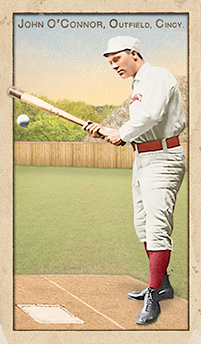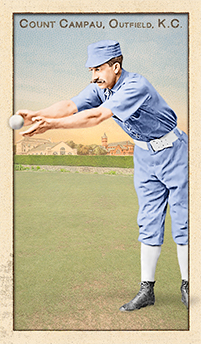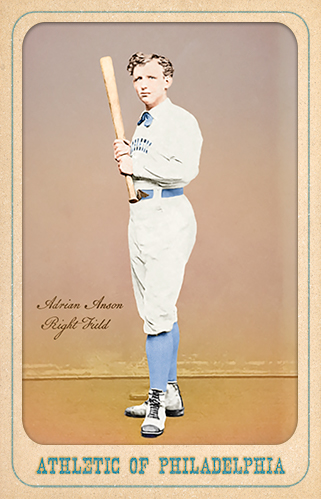- Series: Athletic of Philadelphia: 1874
- City: Philadelphia
- Team: Athletics (NAPBBP)
- League: National Association (NAPBBP)
- Hall: National Baseball Hall of Fame
Adrian Constantine Anson (1852-1922) was Mr. Longevity, a big, brawling cyclone of controversy & batsmanship unrivaled in the early days of pro ball. He set hitting standards that only the greatest future players would approach or break. He also, by dint of his ferocious personality, may have been the single greatest force for segregation in baseball until Branch Rickey began to reverse that sad estate.
- Played a record 27 consecutive years in the NL
- First batter to 3000 hits, using his powerful arms to create line drives with a short swing
- Managed the Chicago NL team to five pennants and still holds the Cub franchise records for hits, doubles, runs scored and runs batted in
- Elected to Hall of Fame: 1939

- Series: Beginnings: 1880's
- City: Louisville
- Team: Colonels
- League: American Association
William Van Winkle “Jimmy” Wolf (1862-1903) played virtually his entire career with Louisville, starting in 1882 when the club was known as the Eclipse and continuing with the Colonels through the 1891 season. He played three games for the Browns in ‘92 before heading, for the first time, to the minors for three campaigns. Known mostly as Jimmy, Wolf had the Chicken moniker hung on him by teammate Pete Browning after Wolf gorged on a pre-game boiled bird and committed several errors that day. By any name, Wolf earned a renown that has since eluded him. He was, arguably, the best hitter in the history of the American Association, and is the league's all-time leader in games played, hits, doubles, triples and total bases. The second-class status of the 19th century’s “junior circuit” has always weighed heavily in Cooperstown evaluations. Jimmy reached his pinnacle in 1890, hitting .363 and leading the post-season tourney with .360 and eight RBI. The right-hander was primarily an outfielder, but eventually saw action at every position. The previous year had immersed Wolf in the most controversy of his career. A feud with manager Dude Esterbrook led to Wolf replacing him. Jimmy faithfully carried out owner Mordecai Davidson’s tough fine schedule for on-field lapses. Things erupted into the first players’ strike and Davidson sold the club mid-summer with Wolf ending his managerial career.
- The trials and tribulations of the 1889 season swirled around Wolf and his hapless teammates en route to a spectacularly dismal record of 27-111. No surprise that tempers flared and fights broke out. Davidson’s obstinance, particularly his penchant for dunning his players, exacerbated the situation. It is to Wolf’s credit that he persevered while holding the captain’s reins and, despite the bad blood, his teammates embraced him once Davidson was gone
- Wolf was intrepid on the ball field and off. In retirement he served as a firefighter in his hometown of Louisville. His tragic death at age 41 resulted from a traumatic brain injury incurred a few years prior to 1903. Wolf was buried beside childhood friend and comrade in arms, Pete "The Louisville Slugger" Browning
- William Van Winkle Jimmy Chicken Wolf. I just had to write that again.
- Wolf enjoys five known poses in the Old Judge canon
- This card of Chicken Wolf represents the 300th and final card in the 1880s: Base Set
- It is truly gratifying to close this series on such a high and symbolic note . . . .
- with an elusive player of some magnitude whom I have been yearning and struggling to get into the series for four years now (this is my fourth attempt at Chicken Wolf as his images are scarce and typically of poor quality)
- who has a name so deep in the alphabet (only 5 OJ subjects follow Wolf alphabetically: Dandy Wood, Pete Wood, Harry Wright, Chief Zimmer & Frank Zinn - with Zinn being the only one to escape this series' reach)
- and with an OJ pose of such repose. Wolf's halfhearted enactment of a slide while resting on a tuft of carpeted grass strikes me more as somebody who is resting after a hard-fought and victorious campaign in the field of dreams . . . . and that is exactly how I feel in bringing this series to a close.
- The first release of this 300th & final card, on August 10, 2017, is the 2,068th card to be made and released from the 1880s: Base set
- I sold the first card from this series, Doc Bushong, on May 8, 2013, for $11.62 to a brave and courageous soul in Wind Gap, Pennsylvania
- I could not have gotten here from there without each and every one of you. Thank you, sincerely, for your tremendous support.
- The journey continues . . . . .

- Series: Beginnings: 1880's
- City: Cincinnati
- Team: Red Stockings (AA)
- League: American Association
John Joseph O’Connor (1866-1937) was as durable as they come. He holds the distinction, with a mere 28 others, of playing in four different decades in the majors. His durability was a product of his toughness. Despite the benign-sounding nickname of “Peach Pie,” O’Connor was known as one of the dirtiest players of his day and hard as nails. He excelled behind the plate, a position that devoured its occupants. With the Cleveland Spiders from 1892-98, O’Connor (also known as “Rowdy Jack”) hit .290+ four straight seasons. In his 21-year big league career, Jack hit a fine .263 He had started out with Cincinnati’s Red Stockings in 1887 and stayed in the Buckeye State with the Columbus Solons and Cleveland until he moved to St. Louis following the ‘98 campaign. He would move on to Pittsburgh and New York before landing back in St. Louis in 1904 where he remained through 1910.
Jack's waning days in St. Louis proved fateful for he and two of the game's all-time great hitters. Nap Lajoie and Ty Cobb were locked in a memorable duel for the batting title (and thus, the 1910 Chalmers Award) as the season wound down. O’Connor was the player/manager of the Browns when Lajoie’s Naps came to town for a season-ending double-header at Sportsman’s Park. History doesn’t record why O’Connor so strongly preferred Nap to win the title, but we might suppose Cobb wasn’t any more beloved in St. Louis than elsewhere. In any event, “Peach Pie” ordered his rookie third baseman Red Corriden to play back . . . way back, as in short left field. Lajoie proceeded to drop five bunts down the line, all for base hits. Lajoie reached base on his 6th at bat on a fielder's error, but O'Connor tried to bribe the official scorer to change the error to a hit, even offering to buy the woman a new wardrobe. The batting title and Chalmers Award went to Cobb despite the host’s accommodation. The difference in final average was minute, and the controversy inspired Chalmers to give both Lajoie and Cobb new cars. But the escapade cost O’Connor his job as league president Ban Johnson ordered him and Browns' owner Robert Hedges fired and banned. Decades later, research found Cobb had been double-credited with one day’s results. In 1981 Lajoie was declared the true winner of the batting title for 1910, by seven thousandths of a point. Rowdy Jack’s revenge….
- O'Connor's stunt got him blacklisted and unofficially banned from major league baseball for life
- At age 46, Jack returned to Cleveland’s Forest City club in 1912 for a last hurrah. No data survives for that team’s year but Baseball Reference records O’Connor managed the squad

- Series: Beginnings: 1880's
- City: Kansas City
- Team: Blues (WA)
- League: Western Association
Charles Columbus Campau (1863-1938) may have been dubbed “The Count,” but he was the King of the Minors in the 19th century. No one matched his offensive output and he was prized especially for his defense. The scion of the French-Canadian founders of his native Detroit, Campau reigned in the society of the city and its ball fields. Educated at Notre Dame, he began playing there at an early age and soon came to dominate with his power and speed. He left Detroit with mentor Al Buckenberger to begin his pro career with Erie of the Interstate League in 1884. Thus began a two-decade tenure, mostly in the minors, that would take the Count to twenty different clubs including brief stints in the majors. His debut was back home with the Wolverines filling in for an injured Sam Thompson in ‘88. He stayed on with the newly constituted International League version of the Wolverines the following season and would have but one more turn in the big leagues, with the Browns in 1890 (save for two games with the Senators in ‘94). This would allow the hard-hitting Campau to claim a rare (unique?) distinction of leading the (minor league) International League and (major league) American Association in home runs in the same season. Charlie was known for his leadership skills and often served as on-field manager. Browns' owner Chris von der Ahe used him so in St. Louis that year and would call him “the best captain I have ever had.” Campau’s batting average could fluctuate, but his speed steadily improved to the point he was running foot races for prizes and was reputed to have never lost a match. The sketchy data of minor league stolen bases leaves a lot unknown but his feats were legendary. He swiped 100 bases in ‘87 and was renowned for a “home run” he hit by rounding the bases on a muffed pop-up in front of the plate.
- Campau continued in the minors through the 1905 season and umpired the following year. Never losing his love for speed, Charlie retired and went into the horse racing business and worked around the nation’s tracks in various capacities the rest of his life
- von der Ahe had sacked his prized manager for faithfully enforcing the owner’s own rules. The Count got a bit of revenge the next day, hitting an inside-the-park grand slam to the delight of St. Louis fans who rained down a deluge of cigars. Enough, Campau said, to open his own store
- Campau enjoys five known poses in the Old Judge canon

- Series: Beginnings: 1880's
- City: Kansas City
- Team: Blues (WA)
- League: Western Association
William Louis Hassamaer (1864-1910) played outfield for three seasons in the National League. His rookie campaign was with the Senators in 1894, the team he would start the ‘95 season with before being sent to Louisville, where he would finish his ML career a year later. Bill made a splash in his first year in the big leagues. On June 13, 1894 he became the 30th ML player to hit for the cycle, in a game against the St. Louis Brown Stockings. The feat had actually been accomplished 36 times previously. Curry Foley recorded the first cycle in 1882 (some sources cite a 1st cycle by George Hall in 1876); Long John Reilly recorded three cycles with the Reds between their stints in both the AA & NL (his first two cycles were only seven days apart); and Dave Orr, Tip O'Neil, Pete Browning & Mike Tiernan had each recorded two cycles by the time Hassamaer earned his membership to the elite club.
Hassamaer’s debut was auspicious in every sense that rookie year. He hit .322 with four homers and 90 RBI. He showed some speed as well, stealing 16 bases. Unfortunately, Hassamaer’s performance would steadily decline thereafter. He never again attained any of the offensive output of that first season. His second year with Washington saw his average drop to .278 with a tail-off in every category. He was purchased by Louisville for $200 on August 23, 1895. The move to Kentucky only sent Bill’s record into a deeper spiral. He batted a mere .208 for the 23 games he played at the end of the ‘95 season. Despite this meager accomplishment, the Colonels gave Hassamaer another shot in ‘96, but his .245 average with little power proved too little and he was released after only 30 games.
Prior to joining the National League, Bill had a successful tenure in the minors. He had begun in 1887 with the Western League’s Kansas City Cowboys, playing full time and hitting .371. After a second year in KC, he bounced around a number of teams and his average fluctuated wildly. His efforts for the Montgomery Colts of the Southern Association in 1893 paved the way for his major league call-up when he hit .321.
- Hassamaer’s swan song came with the Bridgeport Orators of the Connecticut League in 1899 where he played for the club’s namesake and manager, Jim “The Orator” O’Rourke. O’Rourke had enjoyed one of the finest playing careers in the early game and was inducted into the Hall of Fame in 1945




